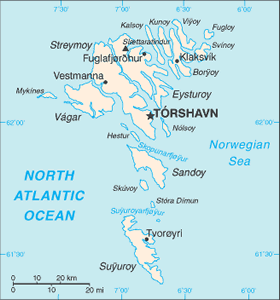The Geography of Faroe Islands
The Geography of Faroe Islands
Faroese Geography
Location: Northern Europe, island group between the Norwegian Sea and the North Atlantic Ocean, about half way between Iceland and Norway
Geographic coordinates: 62 00 N, 7 00 W
Map references: Europe
Area: total: 1,399 sq km land: 1,399 sq km water: 0 sq km (some lakes and streams)
Area - comparative: eight times the size of Washington, DC
Land boundaries: 0 km
Coastline: 1,117 km
Maritime claims: territorial sea: 3 nm continental shelf: 200 nm or agreed boundaries or median line exclusive fishing zone: 200 nm or agreed boundaries or median line
Climate: mild winters, cool summers; usually overcast; foggy, windy
Terrain: rugged, rocky, some low peaks; cliffs along most of coast
Elevation extremes: lowest point: Atlantic Ocean 0 m highest point: Slaettaratindur 882 m
Natural resources: fish, whales, hydropower, possible oil and gas
Land use: arable land: 2.14% permanent crops: 0% other: 97.86% (2005)
Irrigated land: 0 sq km
Natural hazards: NA
Environment - current issues: NA
Environment - international agreements: party to: Marine Dumping - associate member to the London Convention and Ship Pollution
Geography - note: archipelago of 17 inhabited islands and one uninhabited island, and a few uninhabited islets; strategically located along important sea lanes in northeastern Atlantic; precipitous terrain limits habitation to small coastal lowlands


